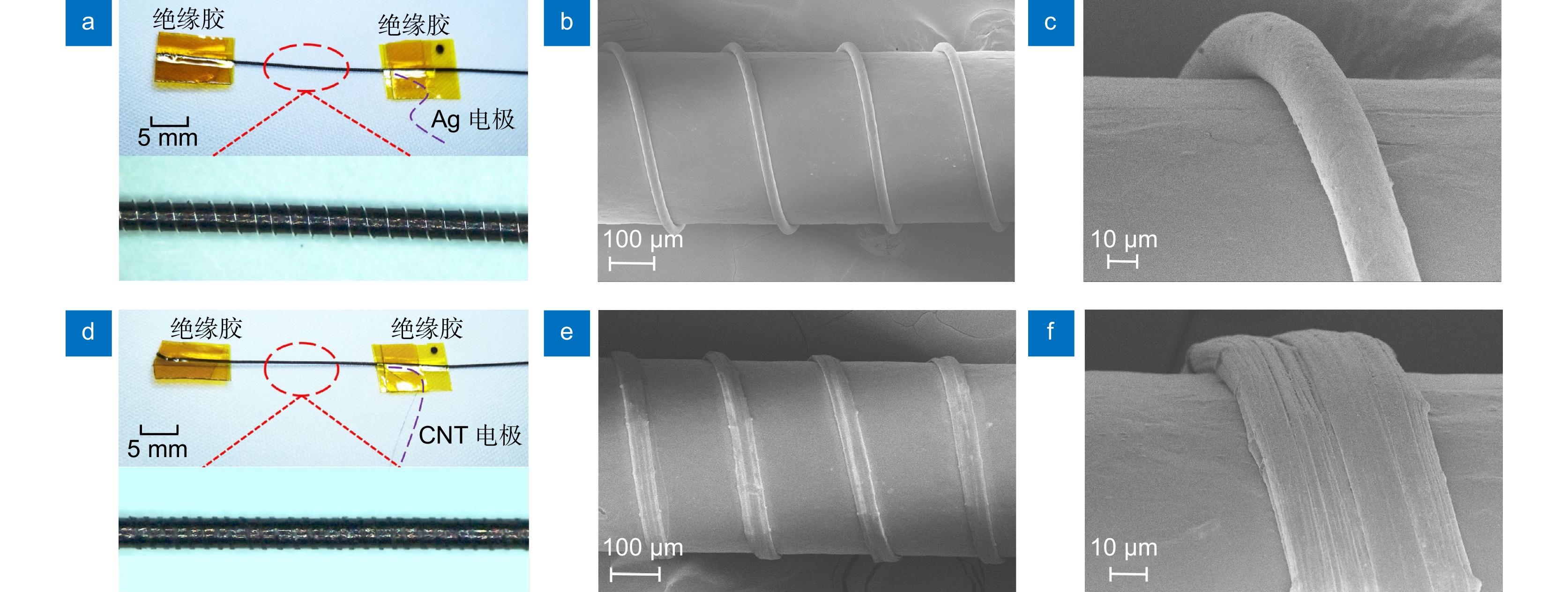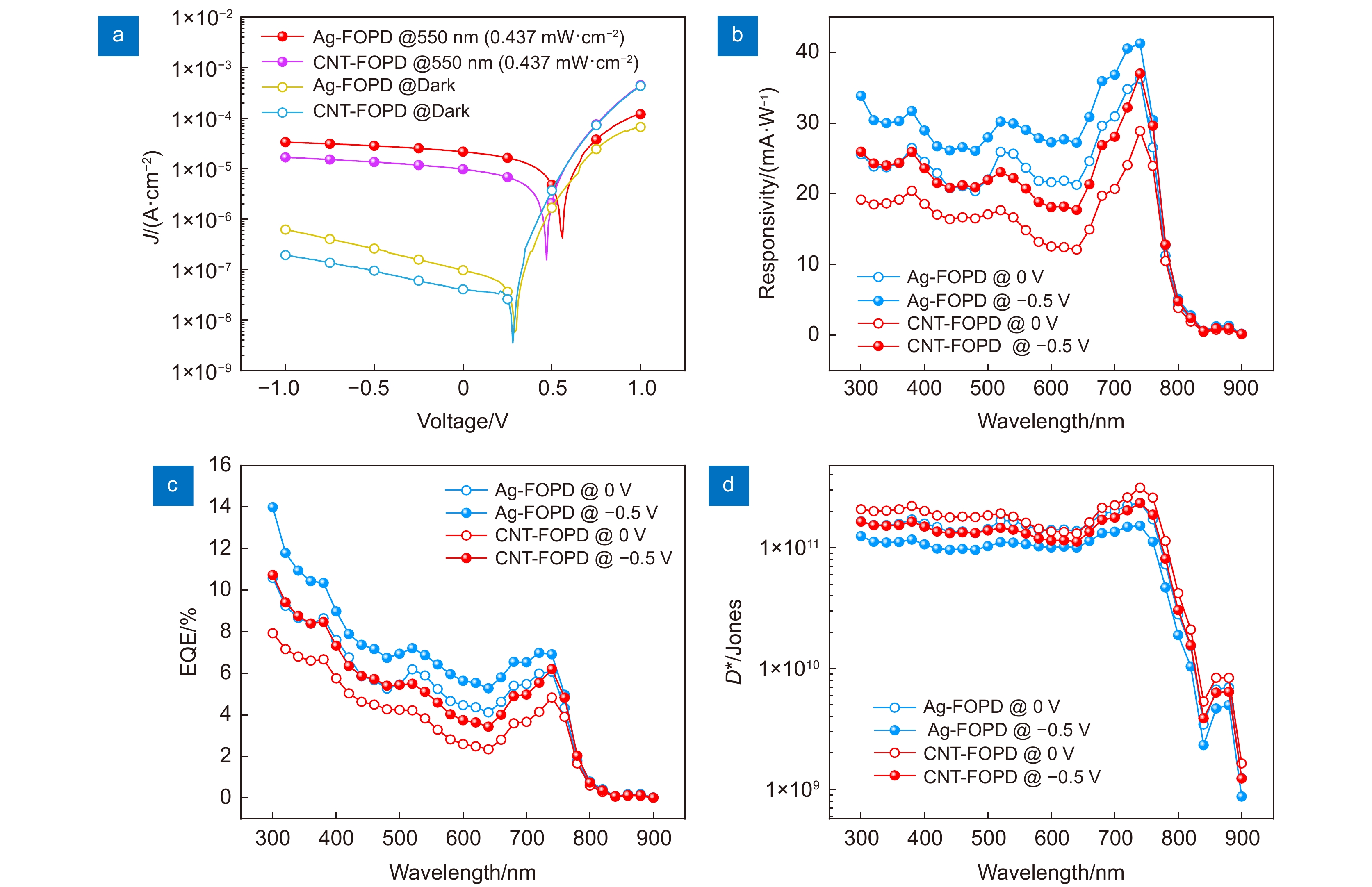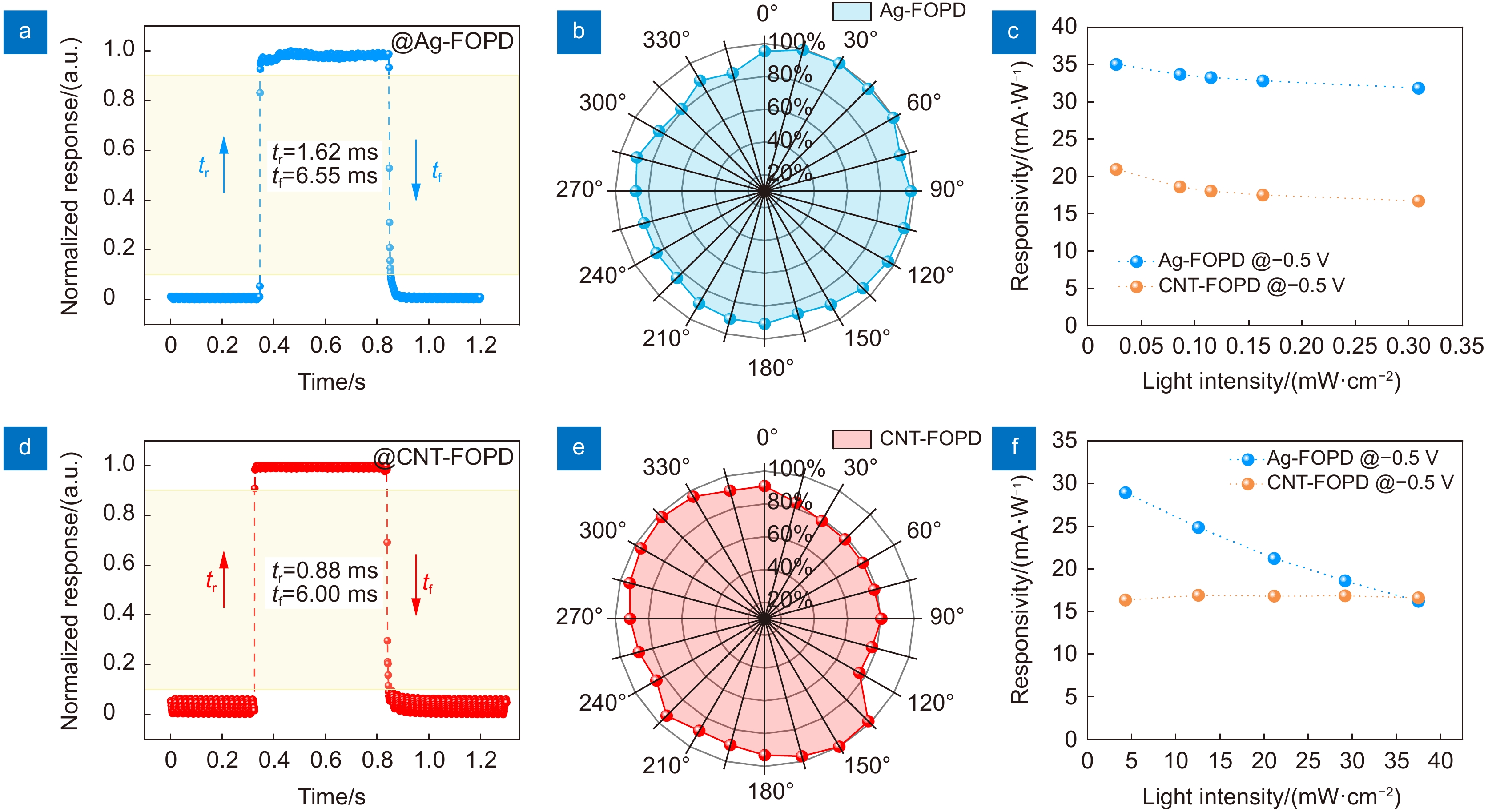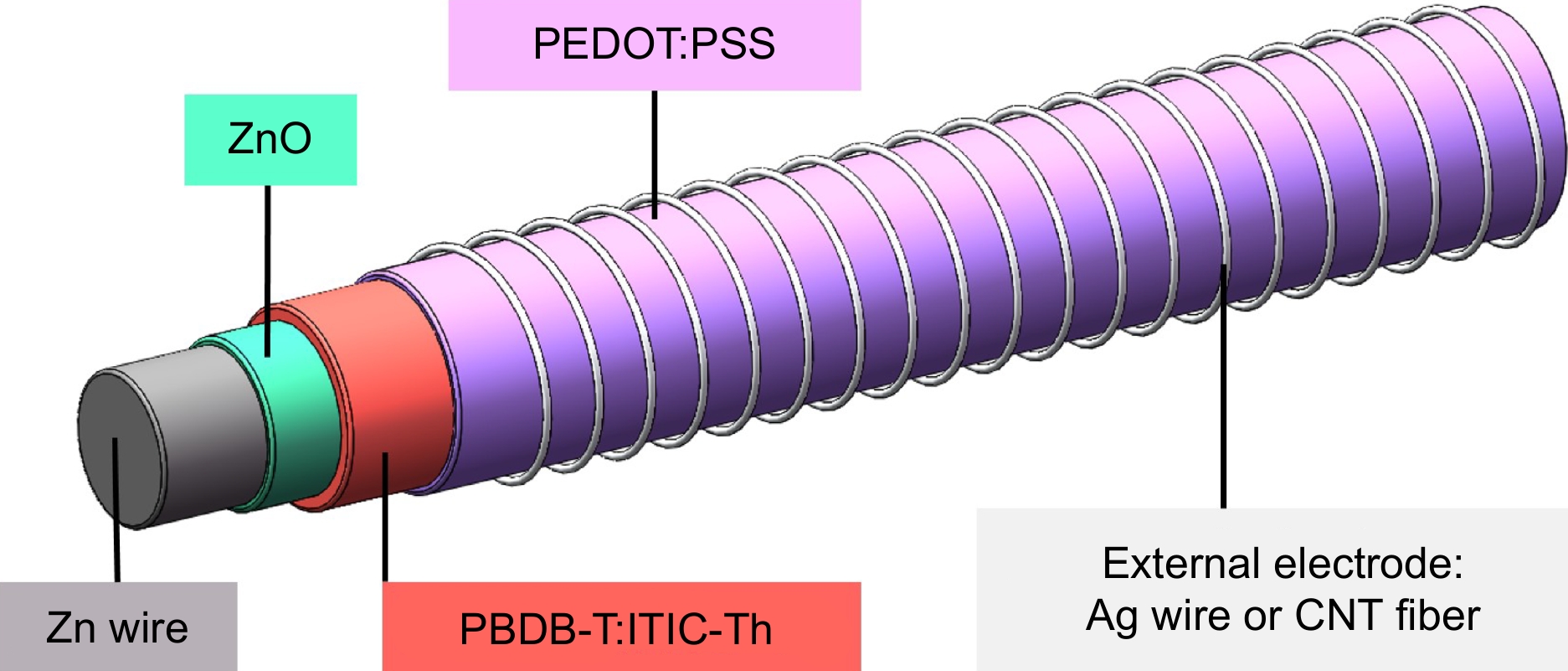-
摘要
纤维状光电探测器因具有柔性可编织、全角度光探测等特性,有望在可穿戴电子领域取得广泛应用。现已报道的纤维状光电探测器多采用无机光敏材料,器件存在机械柔性受限、制备工艺复杂等问题。本文提出制备纤维状有机光电探测器(FOPD),采用浸渍提拉法依次在锌丝表面制备电子传输层(ZnO)、有机体异质结光敏层(PBDB-T:ITIC-Th)和空穴传输层(PEDOT:PSS)等功能层,最后缠绕银丝或碳纳米管纤维(CNT)作为外电极,制备了两种柔性FOPD。结果表明,两种器件在可见光波段均具有优良的响应,整流特性明显,在−0.5 V偏压下比探测率均可达1011 Jones (300 nm~760 nm)。其中,CNT外电极与光敏层的界面接触更佳,器件具有更低的暗电流密度(9.5×10−8 A cm−2,−0.5 V)和更快的响应速度(上升、下降时间:0.88 ms、6.00 ms)。本文的研究有望为柔性纤维器件和可穿戴电子领域的发展提供新思路。
Abstract
Fiber-based photodetectors are expected to be widely used in the field of wearable electronics due to their properties of flexibility, easy-to-weave, and omnidirectional light detection. Currently reported fiber-based photodetectors mostly use inorganic photosensitive materials, which have drawbacks such as limited mechanical flexibility and complex preparation processes. In this paper, we proposed the fiber-based organic photodetector (FOPD). The electron transport layer (ZnO), organic heterojunction photosensitive layer (PBDB-T:ITIC-Th), and hole transport layer (PEDOT: PSS) were prepared on zinc wire by a solution dip-coating method layer by layer. Finally, silver wire or carbon nanotube fiber (CNT) was wrapped as the external electrode, and two kinds of flexible FOPDs were obtained and showed typical rectification characteristics. They showed a specific detection rate of 1011 Jones (300 nm~760 nm) at −0.5 V bias. Due to the better interface contact between the CNT external electrode and photosensitive layer, the CNT-based device exhibited lower dark current density (9.5×10−8 A cm−2, −0.5 V) and faster response speed (rise time of 0.88 ms and fall time of 6.00 ms). The work is expected to provide new ideas for the development of flexible fiber-based devices and wearable electronics.
-
Key words:
- organic photodetector /
- fiber-based photodetector /
- dip-coating /
- twisted electrode
-
Overview
Overview: Organic photodetectors (OPDs) have advantages such as wide material sources, tunable spectrum, solution processing, and low manufacturing cost. They have numerous potential applications in domains of aviation, military, business, medicine, et al. Traditional organic photodetectors owe a planar structure and mostly use indium tin oxide (ITO), silver, aluminum, and other materials as electrodes. The organic photosensitive layer is sandwiched between two asymmetric electrodes to form a "sandwich" structure. However, the rigidity and brittleness of planar substrates constrain their application in flexible and wearable devices. As an inherently flexible and simple-to-weave material, fibers have been widely used in electronic textiles and wearable devices in recent years. For example, there has been substantial research on fibrous solar cells, supercapacitors, light-emitting devices, and physical/chemical sensors. In terms of fiber-based photodetectors. In 2014, Jixun Chen et al used a Ni wire as the core to prepare a NiO-ZnO heterojunction, and a twine Pt wire as the outer electrode to realize ultraviolet detection. In 2018, Xiaojie Xu et al. modified CuZnS: TiO2 array on the Ti wire surface, and wrapped a carbon nanotube fiber (CNT) on the outer layer to realize the collection and transmission of photogenerated carriers. However, most fiber-based photodetectors are based on inorganic photosensitive materials, showing the disadvantages of complicated manufacturing procedures, poor flexibility, and high cost. In this study, a fiber-based organic photodetector (FOPD) was prepared using organic photosensitive material. The electron transport layer (ZnO), organic heterojunction photosensitive layer (PBDB-T:ITIC-Th), and hole transport layer (PEDOT:PSS) were prepared on the surface of zinc wire by dip-coating method. Silver wire or carbon nanotube fiber (CNT) was wrapped as the external electrode, and two kinds of flexible FOPDs were obtained. Both the two devices showed a typical response in the visible band with remarkable rectification characteristics, and exhibited a specific detection rate of 1011 Jones (300 nm~760 nm) at −0.5 V bias. Due to the better interface contact between CNT external electrode and photosensitive layer, the CNT-FOPD showed a lower dark current density (9.5×10−8 A cm−2, −0.5 V) and faster response speed (rise and fall time: 0.88 ms and 6.00 ms). This work is expected to provide new ideas for the development of flexible fibrous devices and wearable electronics.
-

-
图 1 器件制备流程示意图。(a) 预处理后的锌丝;(b) 浸涂并退火制备ZnO电子传输层;(c) 浸涂光敏层并退火;(d) 浸涂空穴传输层并退火;(e) 缠绕外电极;(f) 缠绕电极装置示意图
Figure 1. Schematic diagram of the device preparation process. (a) Pretreated zinc wire; (b) Preparation of the ZnO electron transport layer by dip coating and annealing; (c) Dip-coating the photosensitive layer and annealing; (d) Dip-coating the hole transport layer and annealing; (e) Winding the external electrode; (f) Schematic diagram of the twist equipment
图 2 (a) PBDB-T和(b) ITIC-Th的分子式;(c) PBDB-T与ITIC-Th的吸收光谱;(d) 器件各功能层材料能级排列示意图;(e) 器件截面SEM图
Figure 2. Molecular structures of (a) PBDB-T and (b) ITIC-Th; (c) Normalized absorption spectra of PBDB-T and ITIC-Th; (d) Energy level alignment of the device materials; (e) Cross-sectional SEM image of the device
-
参考文献
[1] Koo J H, Yun H, Lee W, et al. Recent advances in soft electronic materials for intrinsically stretchable optoelectronic systems[J]. Opto-Electron Adv, 2022, 5(8): 210131. doi: 10.29026/oea.2022.210131
[2] Cai S, Xu X J, Yang W, et al. Materials and designs for wearable photodetectors[J]. Adv Mater, 2019, 31(18): 1808138. doi: 10.1002/adma.201808138
[3] Chow P C Y, Someya T. Organic photodetectors for next-generation wearable electronics[J]. Adv Mater, 2020, 32(15): 1902045. doi: 10.1002/adma.201902045
[4] Hatamvand M, Kamrani E, Lira-Cantú M, et al. Recent advances in fiber-shaped and planar-shaped textile solar cells[J]. Nano Energy, 2020, 71: 104609. doi: 10.1016/j.nanoen.2020.104609
[5] Chen D, Jiang K, Huang T T, et al. Recent advances in fiber supercapacitors: materials, device configurations, and applications[J]. Adv Mater, 2020, 32(5): 1901806. doi: 10.1002/adma.201901806
[6] Zhang Z T, Guo K P, Li Y M, et al. A colour-tunable, weavable fibre-shaped polymer light-emitting electrochemical cell[J]. Nat Photonics, 2015, 9(4): 233−238. doi: 10.1038/nphoton.2015.37
[7] Lu L J, Zhou Y J, Pan J, et al. Design of helically double-leveled gaps for stretchable fiber strain sensor with ultralow detection limit, broad sensing range, and high repeatability[J]. ACS Appl Mater Interfaces, 2019, 11(4): 4345−4352. doi: 10.1021/acsami.8b17666
[8] Wang L, Wang L Y, Zhang Y, et al. Weaving sensing fibers into electrochemical fabric for real-time health monitoring[J]. Adv Funct Mater, 2018, 28(42): 1804456. doi: 10.1002/adfm.201804456
[9] Wang L, Fu X M, He J Q, et al. Application challenges in fiber and textile electronics[J]. Adv Mater, 2020, 32(5): 1901971. doi: 10.1002/adma.201901971
[10] Chen J X, Ding L W, Zhang X H, et al. Strain-enhanced cable-type 3D UV photodetecting of ZnO nanowires on a Ni wire by coupling of piezotronics effect and pn junction[J]. Opt Express, 2014, 22(3): 3661−3668. doi: 10.1364/OE.22.003661
[11] Xu X J, Chen J X, Cai S, et al. A real-time wearable UV-radiation monitor based on a high-performance p-CuZnS/n-TiO2 photodetector[J]. Adv Mater, 2018, 30(43): 1803165. doi: 10.1002/adma.201803165
[12] Wang Z N, Yu R M, Pan C F, et al. Piezo-phototronic UV/visible photosensing with optical-fiber-nanowire hybridized structures[J]. Adv Mater, 2015, 27(9): 1553−1560. doi: 10.1002/adma.201405274
[13] Zhu Z F, Ju D, Zou Y S, et al. Boosting fiber-shaped photodetectors via "soft" interfaces[J]. ACS Appl Mater Interfaces, 2017, 9(13): 12092−12099. doi: 10.1021/acsami.7b00811
[14] Lan Z J, Lee M H, Zhu F R. Recent advances in solution-processable organic photodetectors and applications in flexible electronics[J]. Adv Intell Syst, 2022, 4(3): 2100167. doi: 10.1002/aisy.202100167
[15] Li T H, Chen Z X, Wang Y Y, et al. Materials for interfaces in organic solar cells and photodetectors[J]. ACS Appl Mater Interfaces, 2020, 12(3): 3301−3326. doi: 10.1021/acsami.9b19830
[16] Li X R, Du X Y, Zhao J W, et al. Layer-by-layer solution processing method for organic solar cells[J]. Solar RRL, 2021, 5(1): 2000592. doi: 10.1002/solr.202000592
[17] Rio E, Boulogne F. Withdrawing a solid from a bath: how much liquid is coated?[J]. Adv Colloid Interface Sci, 2017, 247: 100−114. doi: 10.1016/j.cis.2017.01.006
[18] Zhou X K, Yang D Z, Ma D G, et al. Ultrahigh gain polymer photodetectors with spectral response from UV to near-infrared using ZnO nanoparticles as anode interfacial layer[J]. Adv Funct Mater, 2016, 26(36): 6619−6626. doi: 10.1002/adfm.201601980
[19] Kolodziejczak-Radzimska A, Jesionowski T. Zinc oxide-from synthesis to application: a review[J]. Materials, 2014, 7(4): 2833−2881. doi: 10.3390/ma7042833
[20] Ren H, Chen J D, Li Y Q, et al. Recent progress in organic photodetectors and their applications[J]. Adv Sci, 2021, 8(1): 2002418. doi: 10.1002/advs.202002418
[21] Zhao W C, Qian D P, Zhang S Q, et al. Fullerene-free polymer solar cells with over 11% efficiency and excellent thermal stability[J]. Adv Mater, 2016, 28(23): 4734−4739. doi: 10.1002/adma.201600281
[22] Lin Y Z, Zhao F W, He Q, et al. High-performance electron acceptor with thienyl side chains for organic photovoltaics[J]. J Am Chem Soc, 2016, 138(14): 4955−4961. doi: 10.1021/jacs.6b02004
[23] Lim F J, Ananthanarayanan K, Luther J, et al. Influence of a novel fluorosurfactant modified PEDOT: PSS hole transport layer on the performance of inverted organic solar cells[J]. J Mater Chem, 2012, 22(48): 25057−25064. doi: 10.1039/C2JM35646E
[24] Wang C Y, Xia K L, Wang H M, et al. Advanced carbon for flexible and wearable electronics[J]. Adv Mater, 2019, 31(9): 1801072. doi: 10.1002/adma.201801072
[25] Jang Y, Kim S M, Spinks G M, et al. Carbon nanotube yarn for fiber-shaped electrical sensors, actuators, and energy storage for smart systems[J]. Adv Mater, 2020, 32(5): 1902670. doi: 10.1002/adma.201902670
[26] Wang C, Zhang X T, Hu W P. Organic photodiodes and phototransistors toward infrared detection: materials, devices, and applications[J]. Chem Soc Rev, 2020, 49(3): 653−670. doi: 10.1039/C9CS00431A
-
访问统计


 E-mail Alert
E-mail Alert RSS
RSS

 下载:
下载:








